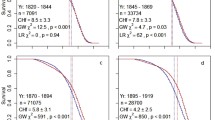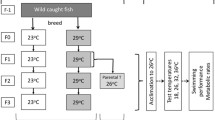Abstract
Much literature argues that natural selection has conserved mechanisms that spontaneously abort fetuses, particularly males, least likely to survive in prevailing environmental conditions including cold ambient temperature. These reports imply the hypothesis that males in gestation during relatively warm periods who confront relatively cold climates in early life live, on average, shorter lives than other males. We estimate the effect of warm-to-cold temperature shifts on the observed lifespan at age one of males born in Sweden from 1850 through 1915. We test this hypothesis using annual cohort lifespan at age 1 year for Swedish males from 1850 to 1915. For our independent variable, we score a series “1” for birth cohorts that experienced relatively warm temperatures in utero but relatively cold temperatures from age 1 through 4 years, and “0” for other cohorts. We use time-series methods, which adjust the data to remove autocorrelation, to estimate the association between these variables. Consistent with theory, males in gestation during relatively warm times who encounter relatively cold temperatures in early life have a shorter lifespan than other males. The association survives adjustment for the longevity of females as well as the main effect of temperatures during gestation and early life. Our findings imply that the increased frequency and amplitude of temperature shifts expected from climate change could influence which humans survive gestation and how long they live.
Similar content being viewed by others
References
Box G, Jenkins G, Reinsel G (1994) Time series analysis: forecasting and control. Prentice Hall, London
Bruckner T, Catalano R (2007) The sex ratio and age-specific male mortality: evidence for culling in utero. Am J Human Biol 19:763–773
Bruckner T, Catalano R (2009) Infant mortality and diminished entelechy in three European countries. Soc Sci Med 68:1617–1624
Catalano R, Bruckner T (2006a) Male lifespan and the secondary sex ratio. Am J Human Biol 18:783–790
Catalano R, Bruckner T (2006b) Secondary sex ratios and male lifespan: damaged or culled cohorts. Proc Natl Acad Sci U S A 103:1639–1643
Catalano R, Bruckner T (2006c) Child mortality and cohort life span: a test of diminished entelechy. Int J Epidemiol 35:1264–1269
Catalano R, Bruckner T, Smith KR (2008) Ambient temperature predicts sex ratios and male longevity. Proc Natl Acad Sci U S A 105:2244–2247
Catalano RA, Saxton K, Bruckner T, Goldman S, Anderson E (2009) A sex-specific test of selection in utero. J Theor Biol 257:475–479
Chang I, Tiao G, Chen C (1988) Estimation of time series parameters in the presence of outliers. Technometrics 30:193–204
Crimmins EM, Finch CE (2006) Infection, inflammation, height, and longevity. Proc Natl Acad Sci U S A 103:498–503
De Lorenzo F, Sharma V, Scully M, Kakkar V (1999) Cold adaptation and the seasonal distribution of acute myocardial infarction. Q J Med 92:747–751
Dickey D, Fuller W (1979) Distribution of the estimators for autoregressive time series with a unit root. J Am Stat Assoc 74:427–431
Fisher RA (1921) Studies in crop variation: an examination of the yield of dressed grain from Broadbalk. J Agric Sci 11:107–135
Forbes LS (1997) The evolutionary biology of spontaneous abortion in humans. Trends Ecol Evol 12:446–450
Gluckman PD, Hanson MA, Spencer HG (2005) Predictive adaptive responses and human evolution. Trends Ecol Evol 20:527–533
Goldsmith JR, Arbeli Y, Stone D (1991) Preventability of neonatal cold injury and its contribution to neonatal mortality. Environ Health Perspect 94:55–59
Grech V, Savona-Ventura C, Vassallo-Agius P (2002) Research pointers: unexplained differences in sex ratios at birth in Europe and North America. BMJ 324:1010–1011
Gunnar M, Quevedo K (2007) The neurobiology of stress and development. Annu Rev Psychol 58:145–173
Hansen D, Moller H, Olsen J (1999) Severe periconceptional life events and the sex ratio in offspring: follow up study based on five national registers. BMJ 319:548–549
Helle S, Helama S, Jokela J (2008) Temperature-related birth sex ratio bias in historical Sami: warm years bring more sons. Biol Lett 4:60–62
Human Mortality Database (2008) University of California, Berkeley (USA), and Max Planck Institute for Demographic Research (Germany). Available online at www.mortality.org or www.humanmortality.de accessed on 14 July 2008
Kelsey RM, Alpert BS, Patterson SM, Barnard M (2000) Racial differences in hemodynamic responses to environmental thermal stress among adolescents. Circulation 101:2284–2289
Kemkes A (2006) Secondary sex ratio variation during stressful times: the impact of the French revolutionary wars on a German parish (1787–1802). Am J Human Biol 18:806–821
Lawlor DA, Leon DA, Davey Smith G (2005) The association of ambient outdoor temperature throughout pregnancy and offspring birthweight: findings from the Aberdeen Children of the 1950s cohort. BJOG 112:647–657
Lee TM, Zucker I (1988) Vole infant development is influenced perinatally by maternal photoperiodic history. Am J Physiol Regul Integr Comp Physiol 255:R831–R838
Lyster WR (1974) Altered sex ratio after the London smog of 1952 and the Brisbane flood of 1965. J Obstet Gynaecol Br Commonw 81:626–631
Meehl GA, Tebaldi C (2004) More intense, more frequent, and longer lasting heat waves in the 21st century. Science 305:994–997
Moberg A, Bergstrom H (1997) Homogenization of Swedish temperature data. The long temperature records from Uppsala and Stockholm. Int J Climatol 17:667–699
Obel C, Henriksen TB, Secher NJ, Eskenazi B, Hedegaard M (2007) Psychological distress during early gestation and offspring sex ratio. Hum Reprod 22:3009–3012
Parry M, Canziani O, Palutikof J, van der Linden P, Hanson C (eds) (2007) Climate change 2007: impacts, adaptation and vulnerability. Contribution of Working Group II to the Fourth Assessment Report of the Intergovernmental Panel on Climate Change. Cambridge University Press, Cambridge, UK, p 1000
Saadat M (2008) Decline in sex ratio at birth after Bam (Kerman Province, Southern Iran) earthquake. J Biosoc Sci 40:935–937
Schar C, Vidale PL, Luthi D, Frei C, Haberli C, Liniger MA, Appenzeller C (2004) The role of increasing temperature variability in European summer heatwaves. Nature 427:332–336
Schön L (2008) Sweden—economic growth and structural change, 1800–2000. In: Whaples R (ed) EH.Net Encyclopedia
Shirtcliff EA, Coe CL, Pollak SD (2009) Early childhood stress is associated with elevated antibody levels to herpes simplex virus type 1. Proc Natl Acad Sci U S A 106:2963–2967
Trivers RL, Willard DE (1973) Natural selection of parental ability to vary the sex ratio of offspring. Science 179:90–92
Wells JC (2000) Natural selection and sex differences in morbidity and mortality in early life. J Theor Biol 202:65–76
Author information
Authors and Affiliations
Corresponding author
Rights and permissions
About this article
Cite this article
Catalano, R.A., Bruckner, T.A., Smith, K.R. et al. Temperature oscillations may shorten male lifespan via natural selection in utero . Climatic Change 110, 697–707 (2012). https://doi.org/10.1007/s10584-011-0119-4
Received:
Accepted:
Published:
Issue Date:
DOI: https://doi.org/10.1007/s10584-011-0119-4




